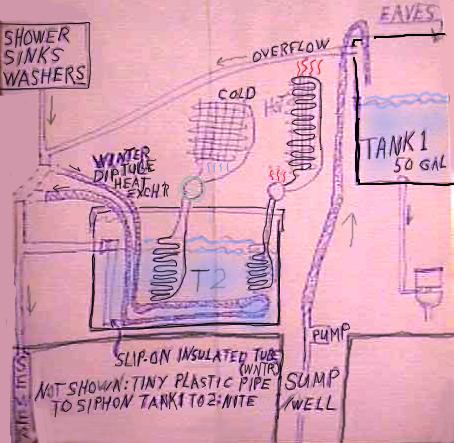
HEAT-STEALING!
The (winter) idea is this: the heat exchanger exhausts air that's already traded nearly all of its excess heat to the air that's coming in to replace it. However, it's a bit warmer than the outside air, and more humid. Humidity is latent heat, & I want that energy back! I paid for it.
. . There's also a lot of heat going down the drain... and I mean literally! Sink & shower-water might still be 85F when it hits the sewer (guessing). Water is heavy, so it takes lots of my gas to heat it, & I want that energy back! I want the water to go down the drain COLD!! Maybe even slushy!
. . This'll take power. A refrigeration unit. But a huge initial expense isn't needed. You can probably pick up a working, if ratty refrigerator at a garage sale for little or nothing. Wait; you'll need two. Their looks are irrelevant, as you're gonna rip 'em apart anyway. Cut, crowbar, torch... whatever (I haven't done it yet), but careful not to damage the working parts: the electrical and plumbing. You'll finish with a skeleton --a compressor between a condenser and the freezing coils. You might be able to salvage some foam or fiberglas.
. . It's possible to use an old ice-maker, & drop ice-shavings down into the sewer, but wait. But wait, that's pulling heat out of water that's 0degrees (usta be 32F). GSHPs pull it out of a mass that's 58F degrees or so --much much more efficient, tho you hafta drill a well for a couple $thousand! Or near-surface loops for a couple hundred.
. . Time to study the diagram.

The simplest way to calculate the produced heat is that: for each thousand watts the compressor uses, you get 4K of heat --1K of the electrical load (everything winds up as heat, eventually, and the motor is indoors). And, assuming a COP of 3, 3K pulled out of the water. It can run continuously, if a supply of water is introduced --sufficient to just avoid freezing. An insulated dip-tube takes chilled water from the very bottom up to the overflow and into the sewer.
...a new idea, even as I type: the ground below is (supposedly) that famous 58 degrees. If you wanna drill a well (perhaps DIY), all you'd need is a circuit of plastic pipe down into it and back, dip thru an exchanger in tank2, and back down. It would continuously thermo-siphon (no pump!) heat from the depths up into your tank and radiate from your condensor into your house. A cheap, simple, and reliable GS-Heat Pump! You'd want to use a good-sized compressor to take proper advantage of that setup.
. . WINTER: Water from the sinks and shower runs down a pipe --separate from sewage. It runs thru a large aluminum pipe --volume of a couple gallons-- more if possible-- that dips into tank #2 and runs around the bottom of it, exchanging its heat into the already-chilled water of the tank, then out again & into the sewer --without mixing with the water in tank 2.
. . The water is chilled by the immersed freezer-section of your stripped refrigerator.